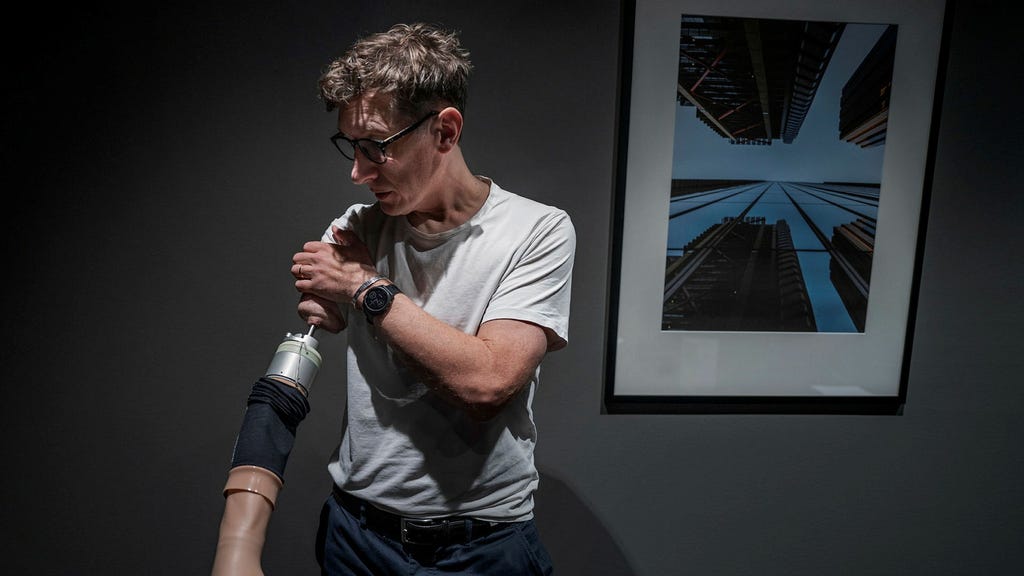In February 1997, Ulf Karlsson, a young sailor brimming with aspirations of becoming a sea captain, experienced a life-altering accident aboard a cargo ship bound for Germany. While performing maintenance on a large fan in the cargo hold, the unthinkable occurred: the fan unexpectedly activated, severely injuring his arm. The damage was so extensive that he required immediate helicopter transport to England for an amputation. This tragic event abruptly halted his burgeoning maritime career and initiated a long and arduous journey to regain lost functionality and independence. He was fitted with a socket prosthesis, a common solution for amputees, but the device proved uncomfortable and impractical, leading him to abandon it after a few years. This marked the beginning of a period of frustration and adaptation as Ulf navigated daily life with a significant physical limitation.
Eighteen years later, a beacon of hope appeared on Ulf’s horizon. He connected with researchers at Chalmers University of Technology in Gothenburg, Sweden, who were pioneering a groundbreaking new type of prosthetic arm controlled by implanted electrodes. This cutting-edge technology offered the potential to restore a level of control and dexterity previously unimaginable with traditional prosthetics. Ulf underwent several surgeries in 2015 and 2016 to prepare for the experimental prosthetic. The procedure involved osseointegration, a technique where a titanium screw is surgically implanted into the bone, providing a direct and stable connection for the prosthesis. The results were transformative. The newfound ability to perform simple tasks, like filling a glass of water or slicing a tomato, brought a dramatic improvement to Ulf’s quality of life, radiating a palpable sense of renewed hope and independence.
However, this promising chapter took an unexpected turn. Dagens Nyheter, a leading Swedish newspaper, launched an investigation into the Chalmers research center, revealing that researchers had conducted human experiments without obtaining the necessary ethical approvals. While Ulf’s participation was part of an approved study, the scandal cast a shadow over the project and ultimately led to the closure of the research center, leaving Ulf and other participants in a precarious situation. Their lifeline to technical support for the complex prosthetic technology vanished, leaving them with devices that, while revolutionary, were still experimental and prone to malfunctions.
Following the closure of the research center, Ulf’s prosthetic began experiencing intermittent failures. A necessary component replacement in the autumn exacerbated the problems, requiring software adjustments that were underway when the research center abruptly shut down. The loss of expert support rendered him unable to rectify the issues, leaving him with an unreliable device that functioned only sporadically. This instability created a frustrating paradox: a technologically advanced prosthetic with the potential to enhance his life became a source of anxiety and dependence, sometimes performing flawlessly and at other times failing completely. This uncertainty drastically impacted his daily life, highlighting the vulnerability of patients reliant on experimental technologies.
The Dagens Nyheter investigation further revealed the plight of other study participants, including Rickard Nordmark, who also experienced problems with his prosthetic hand’s control system. Like Ulf, Rickard had initially experienced significant improvement in his quality of life with the prosthetic, bringing him closer to the functionality of a natural hand. However, the loss of technical support left him with a device that was less effective than what he had before, compounding his frustration and sense of abandonment. Chalmers University deflected responsibility to Sahlgrenska University Hospital, claiming that patient care was their purview, despite Chalmers having been the primary point of contact for these patients for a decade. This bureaucratic entanglement left the patients trapped between two institutions, neither of which seemed willing or able to provide the necessary ongoing technical support for their implanted devices.
Sahlgrenska, while acknowledging contact with the patients, admitted to a lack of clarity regarding the regulatory framework and the complexities involved in supporting experimental medical technology. They attributed the delay in providing a solution to the intricate regulations surrounding medical devices, a process known for its lengthy timelines. While acknowledging the unique situation of the patients – with the experimental technology literally integrated into their bodies – Sahlgrenska downplayed the risks associated with the implanted electrodes, comparing them to commonly used devices like pacemakers. Despite acknowledging the urgency of the situation, a concrete solution remained elusive, with Sahlgrenska only offering a tentative timeline for a preliminary assessment sometime in the next year. This protracted uncertainty left patients like Ulf and Rickard in limbo, grappling with malfunctioning devices and the fear of being permanently left with technology that could no longer be maintained.














